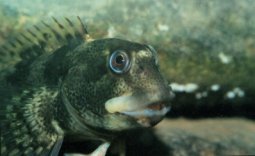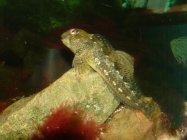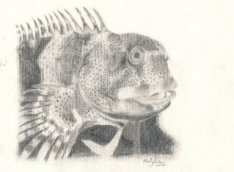|
|
||||||||
|
The Common Blenny Or Shanny |
||||||||
". .small usually scaleless fishes with comb-like teeth living about rocky shores; territorial and hole-dwelling"
Common Blenny or Shanny, |

|
|||||||
| Lipophrys
Pholis1 (Linnaeus,
1758).
1Greek, pholis, -idos = scale Well known to rockpoolers, lives in rock pools and shallow seas all over Europe as far as Southern Spain. Using strong teeth, it feeds on barnacles and molluscs such as littorinids (winkles). Known to leave the water in spring and perch on rocks near pools. Normally reaches 13cm long however older fish may grow to 16cm. Seem to thrive in native marine aquarium however the aquarium does need to be covered as they will attempt to leave the water and jump out! During the breeding season, male blennies turn almost black with white lining around the mouth. "Homing" behaviour has been observed, the fish returning to the same rock pool between tides.
The female blenny produces up to 8000 eggs which are laid in crevices or under rocks during late winter/ early spring. These are guarded by the male, which fans water over the clutch. Fry emerge after six to eight weeks |
There are a number of other blenny species found in UK Waters including The Tompot Blenny, Yarrell's Blenny, Butterfly Blenny, Montagu's Blenny.
|
|||||||

